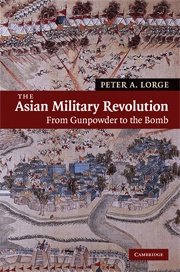Book contents
- Frontmatter
- Contents
- List of maps
- Acknowledgments
- Chronology
- Glossary
- Introduction
- 1 China through the Yuan
- 2 Japan and the wars of unification
- 3 The Chinese military revolution and war in Korea
- 4 Southeast Asia
- 5 South Asia to 1750
- 6 The military revolution in South Asia, 1750–1850
- 7 The arrival and departure of the West
- Conclusion
- Index
- References
6 - The military revolution in South Asia, 1750–1850
Published online by Cambridge University Press: 05 June 2012
- Frontmatter
- Contents
- List of maps
- Acknowledgments
- Chronology
- Glossary
- Introduction
- 1 China through the Yuan
- 2 Japan and the wars of unification
- 3 The Chinese military revolution and war in Korea
- 4 Southeast Asia
- 5 South Asia to 1750
- 6 The military revolution in South Asia, 1750–1850
- 7 The arrival and departure of the West
- Conclusion
- Index
- References
Summary
The introduction of European firearms and training after 1750 brought the European military revolution to South Asia. European mercenary officers taught local infantry European tactics, and employed improved artillery to greater effect both in the field and in sieges. Improved flintlocks with socket bayonets, coupled with European training, shifted the balance of power on the battlefield from the cavalry to the infantry, though this really accelerated a pre-existing native trend in this direction. Cavalry remained on the battlefield, just as in Europe, for both practical and traditional reasons. The aristocracy was still wedded to the horse as its particular military accoutrement, but heavy cavalry soon disappeared. These technological and tactical changes in warfare hastened the decline of the existing social and political order at the local and provincial levels, but arrived too late to have much effect upon the senescent Mughal court. By 1750 the Mughal government was a spent force, leaving the subcontinent politically vulnerable to outside, in this case European, interference.
South Asian military practice shadowed European practice for the next century, and, it has been argued, even contributed to Western military practice through the Asian command experiences of men like the Duke of Wellington. It would still require a century for the increasing effectiveness of the infantry almost completely to undermine the battlefield use of South Asian cavalry. Moreover, the strength of infantry and artillery induced profound political shifts that laid the foundation of the modern Indian state.
- Type
- Chapter
- Information
- The Asian Military RevolutionFrom Gunpowder to the Bomb, pp. 133 - 153Publisher: Cambridge University PressPrint publication year: 2008

